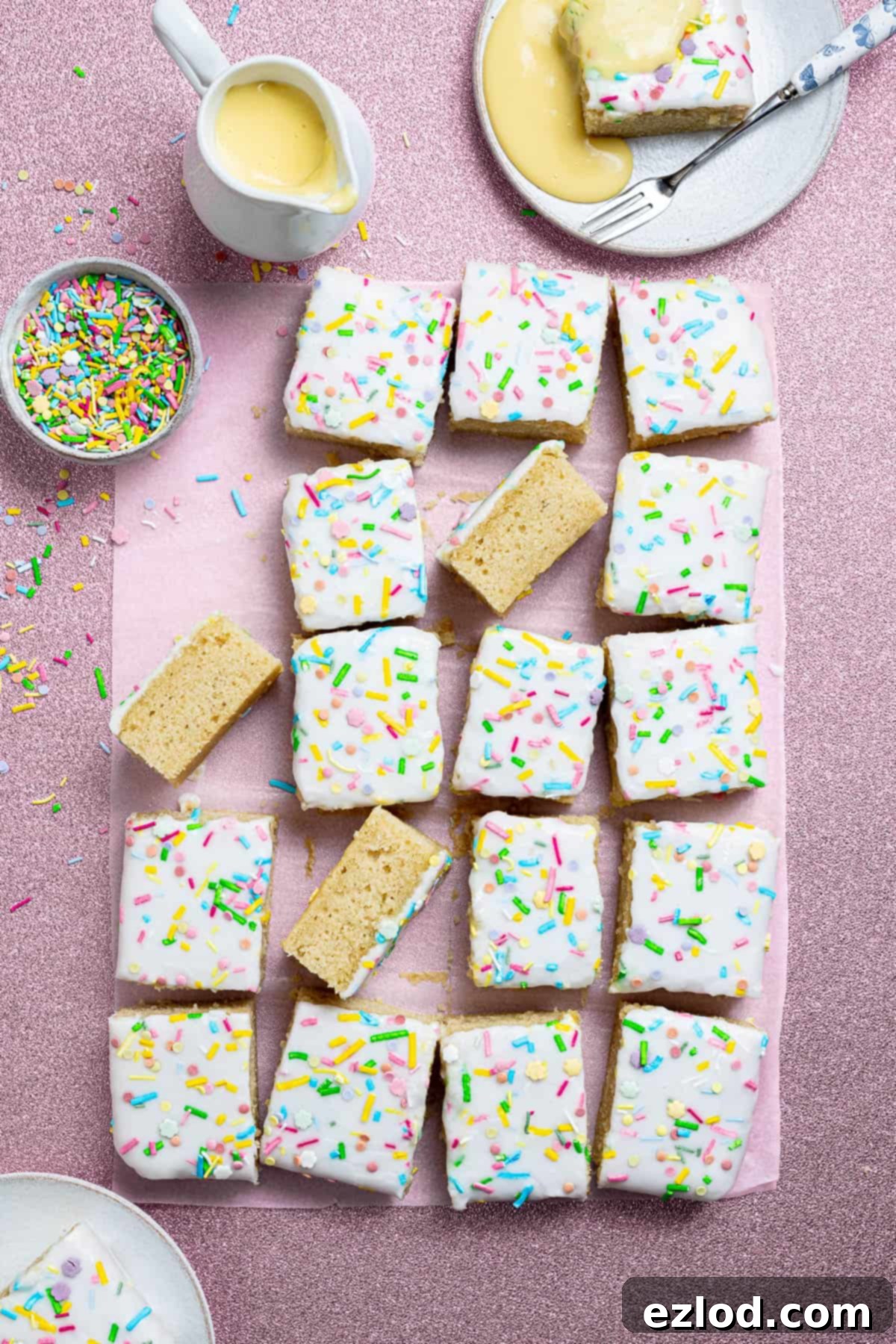The Ultimate Vegan School Cake: A Nostalgic, Easy-to-Make Traybake with Vanilla Glace Icing and Sprinkles
Step back in time to cherished childhood memories with this incredible Vegan School Cake. This nostalgic traybake is an authentic homage to classic British school dinners, offering a comforting slice of the past in a delicious, plant-based format. Imagine a beautifully soft, fluffy vanilla sponge cake, generously topped with a pristine white glace icing, and finished with a scattering of vibrant, colourful sprinkles. It’s not just a dessert; it’s a journey back to simpler times, making it the ultimate comforting pudding for any occasion.
Crafting this delightful cake is surprisingly quick and straightforward, perfect for bakers of all skill levels. Its inherent simplicity is part of its charm. While utterly delicious served on its own, its nostalgic appeal is truly elevated when paired with generous lashings of warm creamy vegan custard, transforming it into a truly indulgent dessert experience.
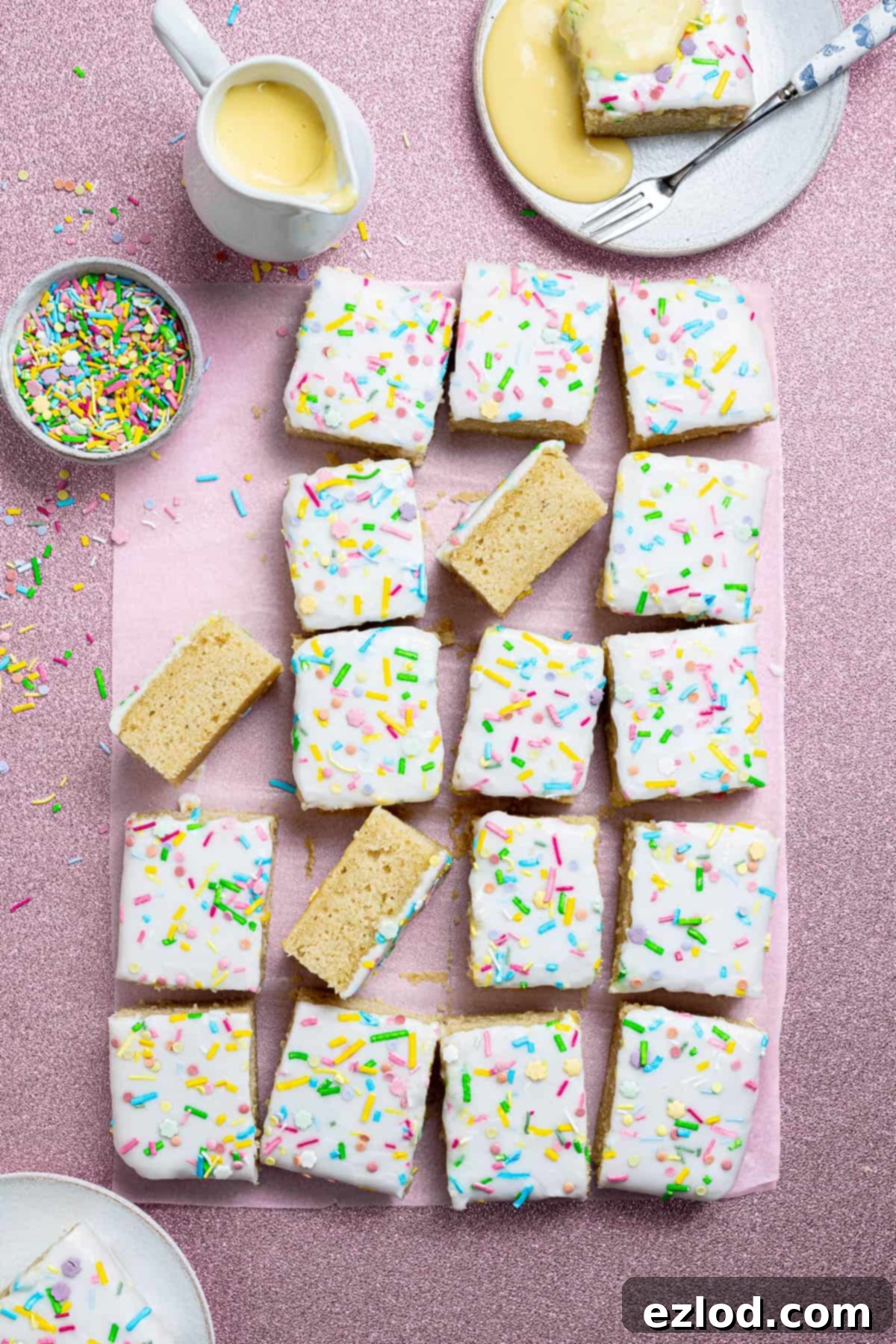
What Exactly is “School Cake”? A Trip Down Memory Lane
For those outside the UK or who simply missed out on the unique culinary experience of British school dinners, ‘school cake’ might sound a little mysterious. However, for many Britons, especially those who grew up in the latter half of the 20th century, this old-school cake is a beloved institution. It’s a quintessential classic, frequently served as the highlight of ‘pudding’ during school lunchtimes. While its presence in contemporary school canteens might be a thing of the past, its place in the hearts and memories of countless individuals remains firmly cemented.
At its core, school cake is an incredibly straightforward yet utterly satisfying creation. It’s essentially a perfectly baked vanilla sponge traybake or sheet cake, distinguished by its simple topping of water icing (glace icing) and a generous shower of colourful sprinkles. This no-fuss dessert is typically cut into squares or rectangular chunks, making it ideal for serving a crowd. The magic truly happens when it’s served, as tradition dictates, with an ample amount of rich custard, creating a truly authentic and deeply nostalgic dessert experience.
The beauty of this retro cake lies not only in its taste but also in its effortless preparation. It’s remarkably quick and easy to make, requires no fancy decorating skills whatsoever, and its traybake format means it naturally feeds a good number of people. This makes it a fantastic choice for family gatherings, parties, or simply when you’re craving a taste of nostalgia without the fuss.
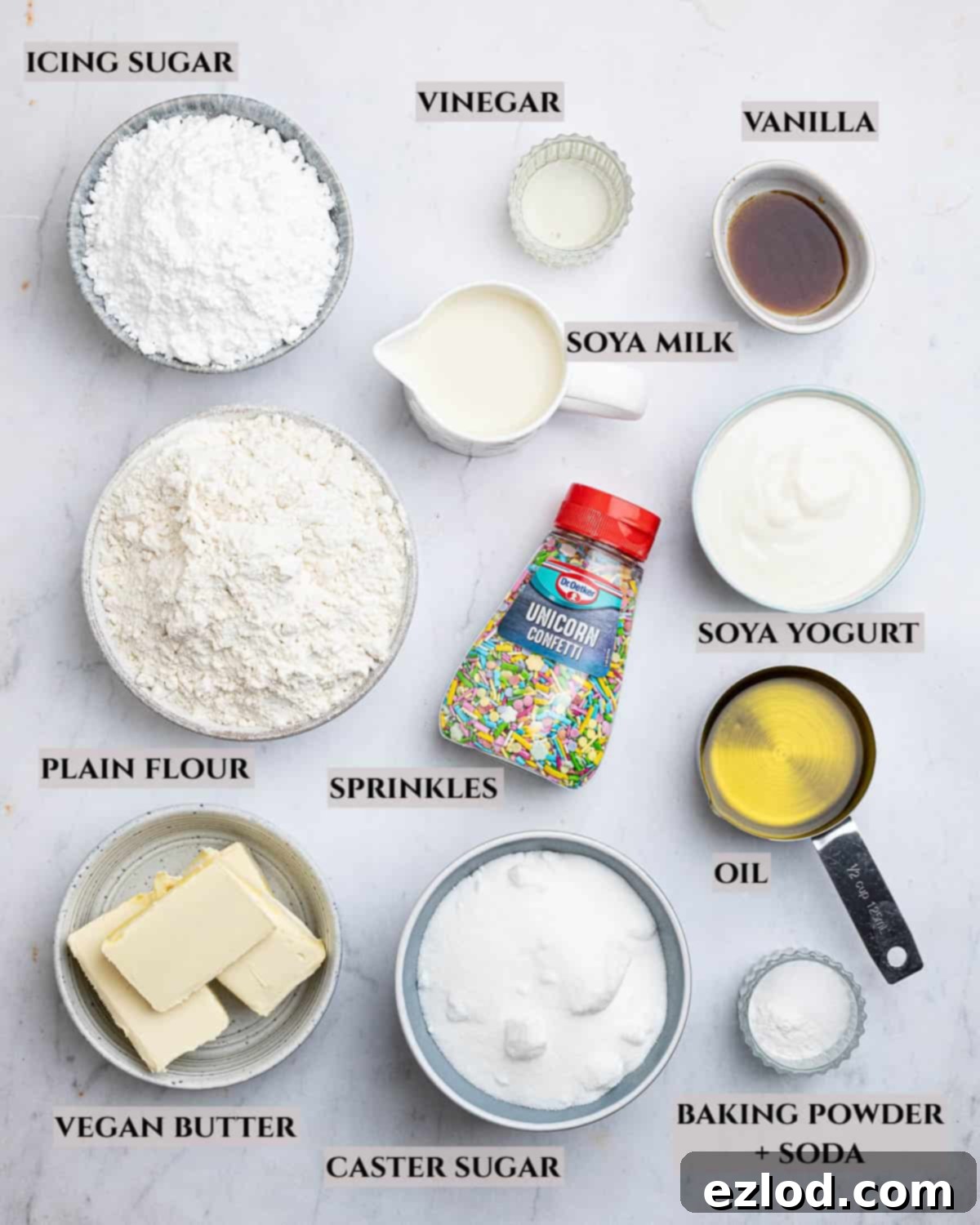
Essential Ingredient Details for Your Vegan School Cake
Creating the perfect vegan school cake relies on understanding each ingredient’s role. Here’s a detailed look at what you’ll need and why:
Sprinkles: A school cake simply isn’t complete without its signature colourful sprinkles! It’s crucial to double-check that the sprinkles you choose are genuinely vegan-friendly. Many common brands unfortunately contain beeswax (E901) as a glazing agent or use non-vegan colourings like cochineal (E120). For those in the UK, I’ve had great success with Dr. Oetker Unicorn Confetti, which is a rare vegan gem in their otherwise mostly non-vegan sprinkle range. For a wider selection, many excellent vegan sprinkles can be found online, ensuring your cake is both delicious and ethically sound.
Oil + Vegan Butter: The combination of liquid oil and solid vegan butter in this cake batter provides a delightful synergy, delivering the best of both worlds: exceptional flavour and superior moisture. Any neutral-flavoured liquid oil will work perfectly – I often use a mild olive oil for its subtle notes. Avoid strong-tasting oils like extra virgin olive oil or coconut oil, as they can overpower the delicate vanilla flavour. For the vegan butter, ideally opt for a block variety (like Naturli’ or Flora Plant Butter) for its consistent texture and fat content, though a good quality spreadable vegan butter (not a ‘light’ version, which contains more water) can also be used.
Non-Dairy Yogurt: I am a huge advocate for incorporating plant-based yogurt into vegan cakes. It’s an excellent natural egg replacer, contributing significantly to the cake’s moistness and tender crumb. Beyond texture, it also adds a subtle tang and depth of flavour that beautifully complements the vanilla. Both soy and coconut yogurts perform wonderfully in this recipe. If you find yourself without non-dairy yogurt, you can substitute it with an equal amount of additional non-dairy milk, though the cake might be slightly less moist.
Baking Powder and Bicarbonate of Soda (Baking Soda): It’s essential to use both leavening agents in this recipe, as they are not interchangeable. Baking powder provides an initial lift, while bicarbonate of soda reacts with the acidic ingredients (like vinegar and yogurt) to create additional carbon dioxide bubbles, ensuring a wonderfully light and fluffy texture for your sponge. This dual action is key to a perfectly risen cake.
Milk: Almost any variety of unsweetened non-dairy milk will work well, with the exception of thick tinned coconut milk, which is too rich. My personal preference for baking is unsweetened soy milk, primarily because its higher protein content mimics the properties of dairy milk more closely, contributing to better structure and a more tender crumb in baked goods. However, almond, oat, or rice milk can also be successfully used.
Vinegar: Don’t skip the vinegar! It’s a vital ingredient that acts as an activator for the bicarbonate of soda (baking soda). The chemical reaction between the acid in the vinegar and the baking soda creates gas, which helps the cake rise beautifully and achieves that coveted fluffy, airy texture. White wine vinegar or apple cider vinegar are both excellent choices.
Sugar: For the cake itself, either caster sugar (superfine granulated sugar) or standard granulated sugar is perfectly fine. I strongly advise against swapping this for liquid sweeteners, sugar alternatives, or other types of sugar (like brown sugar or coconut sugar), as it will significantly alter the cake’s texture and moisture balance. You will also need icing sugar (also known as powdered sugar or confectioners’ sugar) for the smooth, classic glace icing.
Vanilla Extract: To achieve that classic, comforting vanilla flavour, a good quality vanilla extract is paramount. Vanilla extract is superior to artificial vanilla essence. For an even richer and more complex vanilla profile, consider using vanilla bean paste, which often contains flecks of real vanilla bean for an enhanced visual and flavour experience.
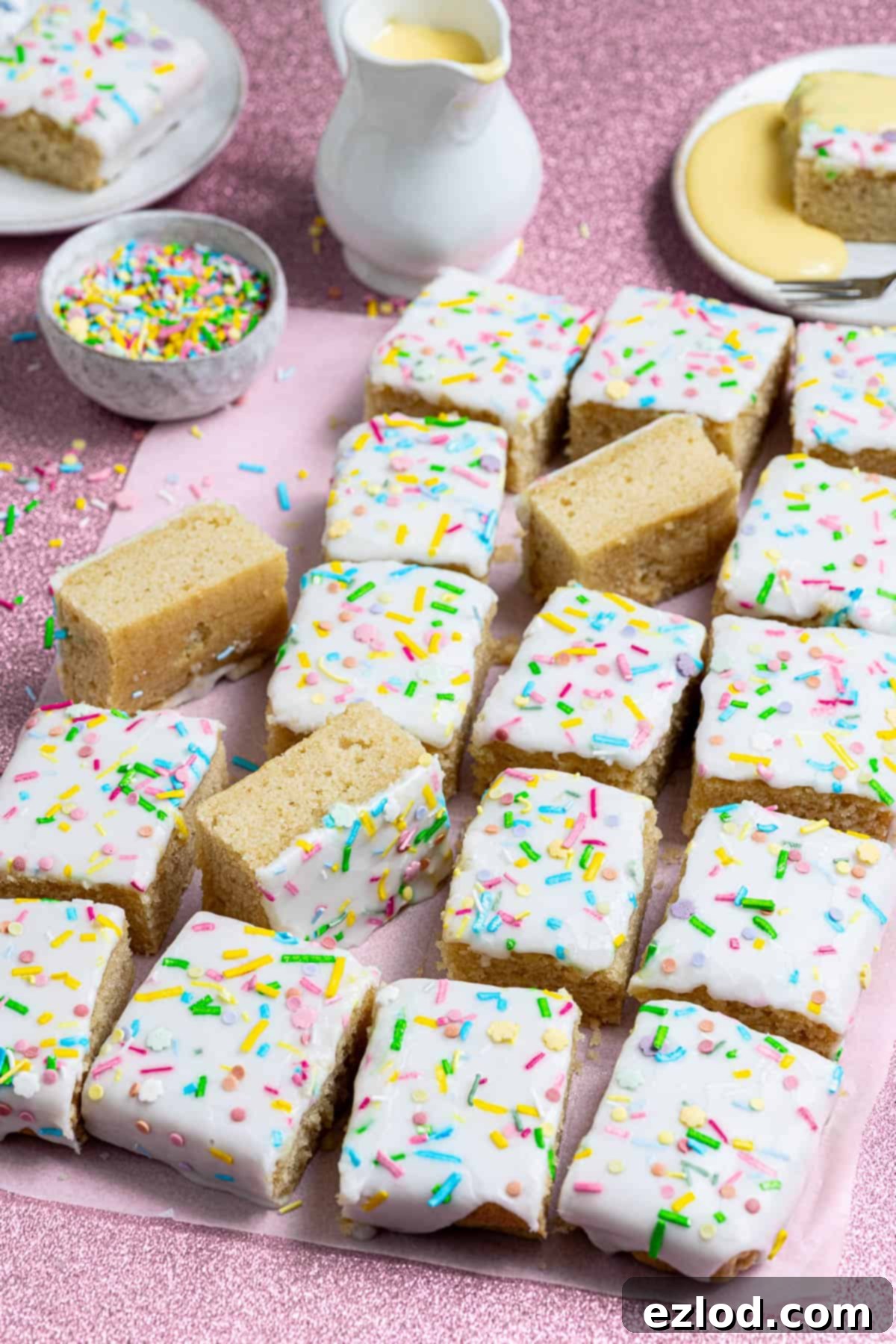
How To Make Your Delicious Vegan School Cake
(For precise measurements and detailed step-by-step instructions, please refer to the comprehensive recipe card located at the very bottom of this page.)
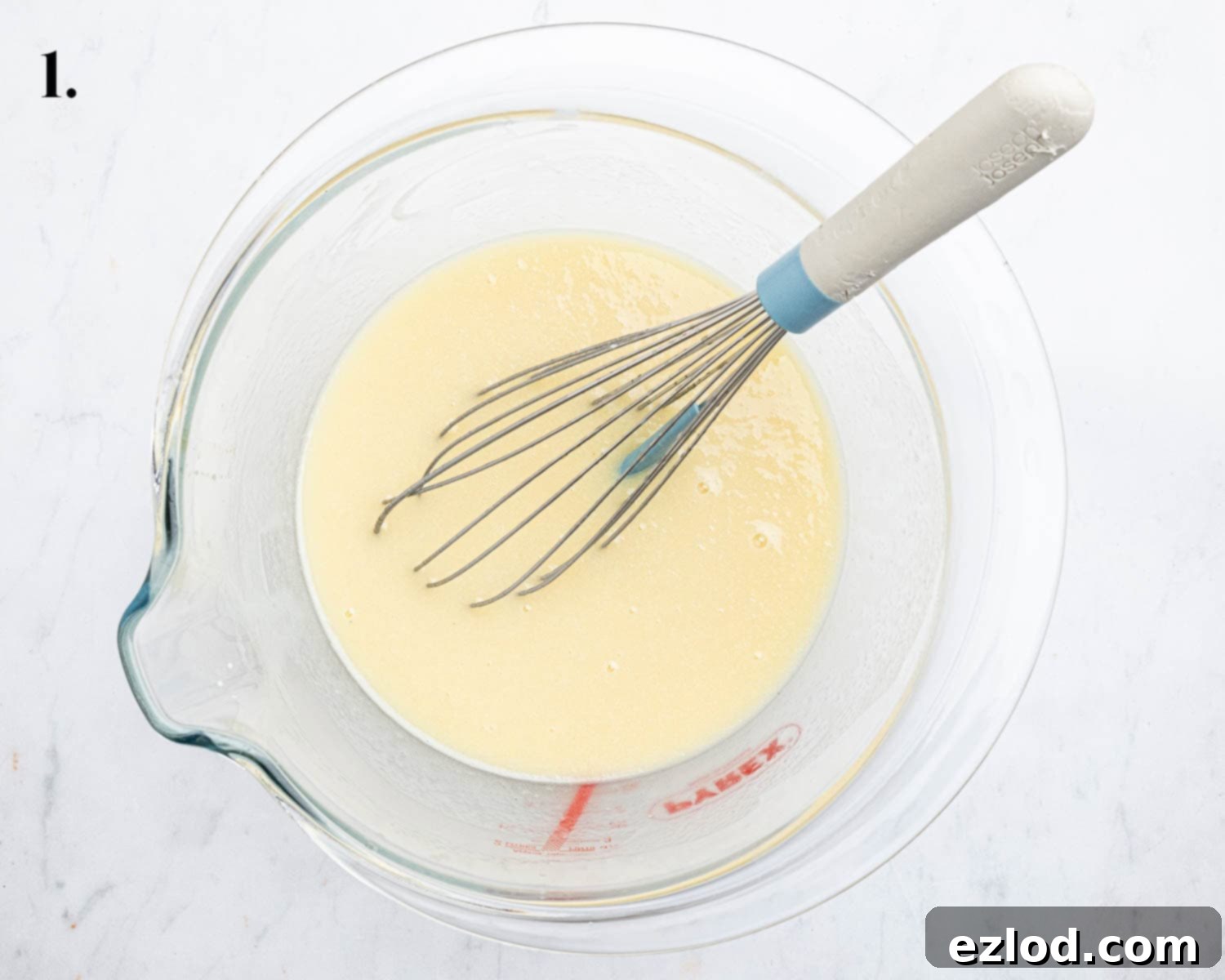
- Step 1: In a spacious mixing bowl, combine the milk, yogurt, oil, melted butter, sugar, vinegar, and vanilla extract. Whisk these wet ingredients together thoroughly until well combined and smooth.
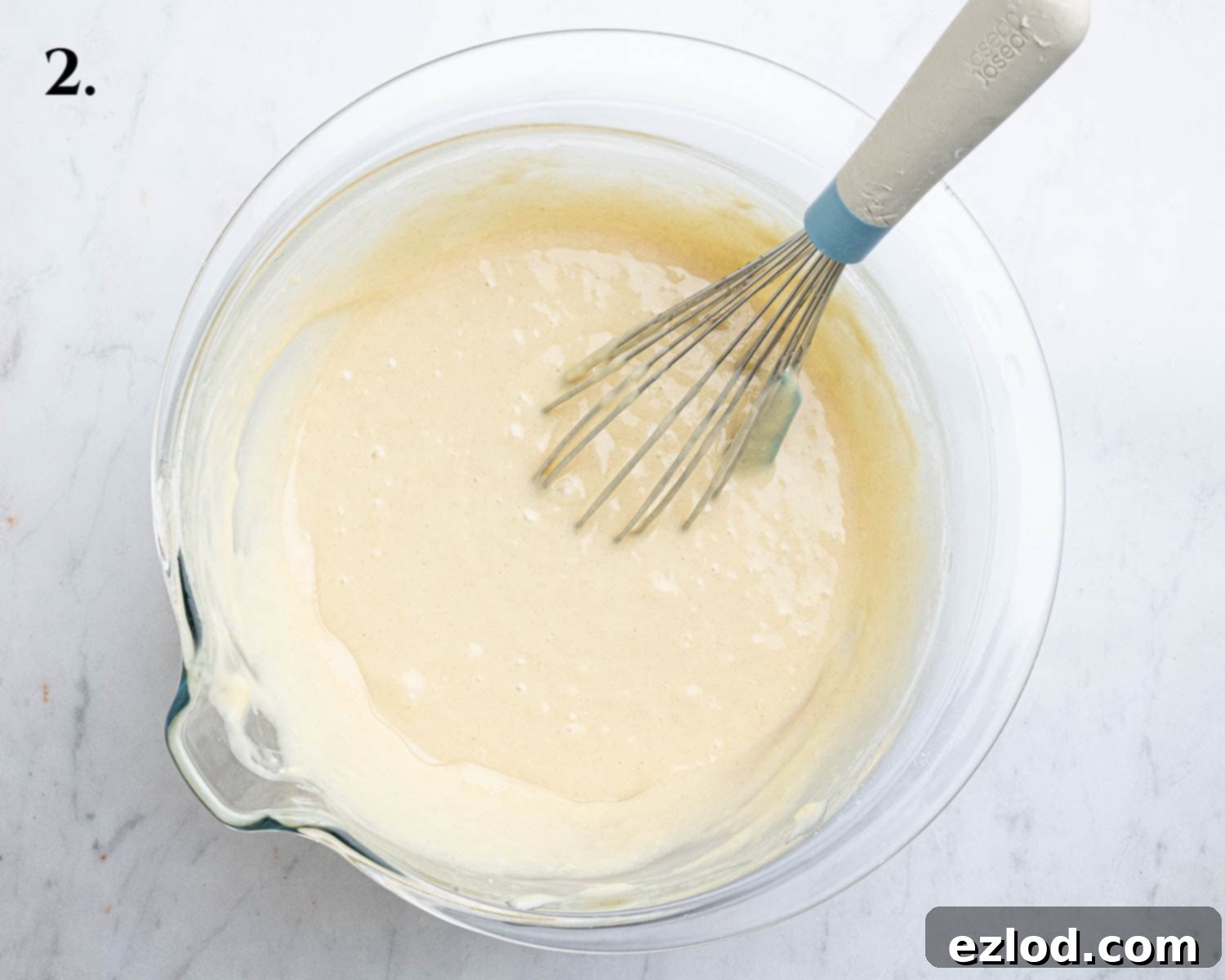
- Step 2: Into the wet mixture, whisk in the baking powder, bicarbonate of soda (baking soda), and salt. Once these are incorporated, gently whisk in the plain (all-purpose) flour until just combined, ensuring no dry lumps remain. Be careful not to overmix.
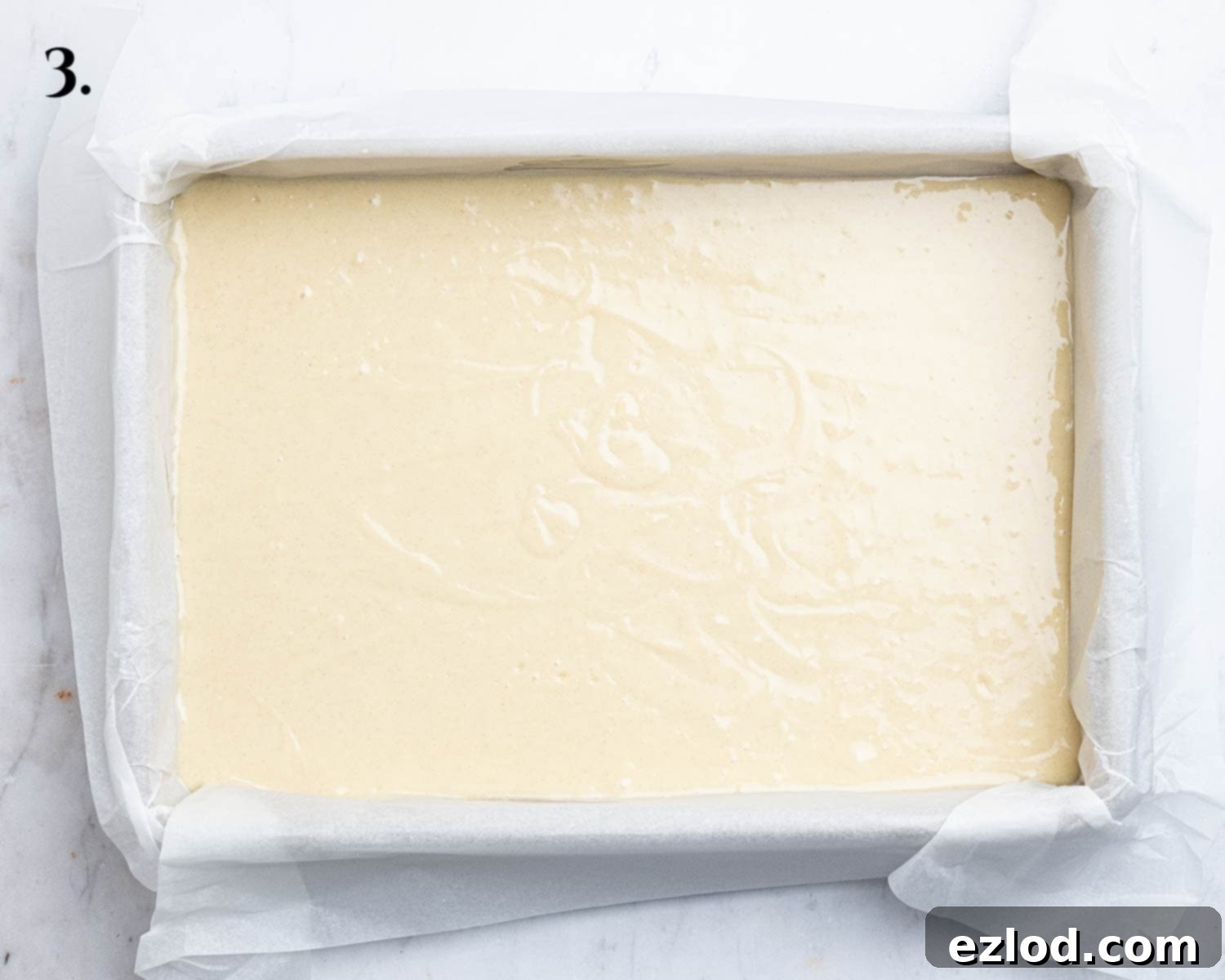
- Step 3: Carefully pour the prepared cake batter into your lined 23 x 33 cm (9 x 13 inch) rectangular cake tin. Use a spatula to spread the batter evenly across the tin, creating a level surface.
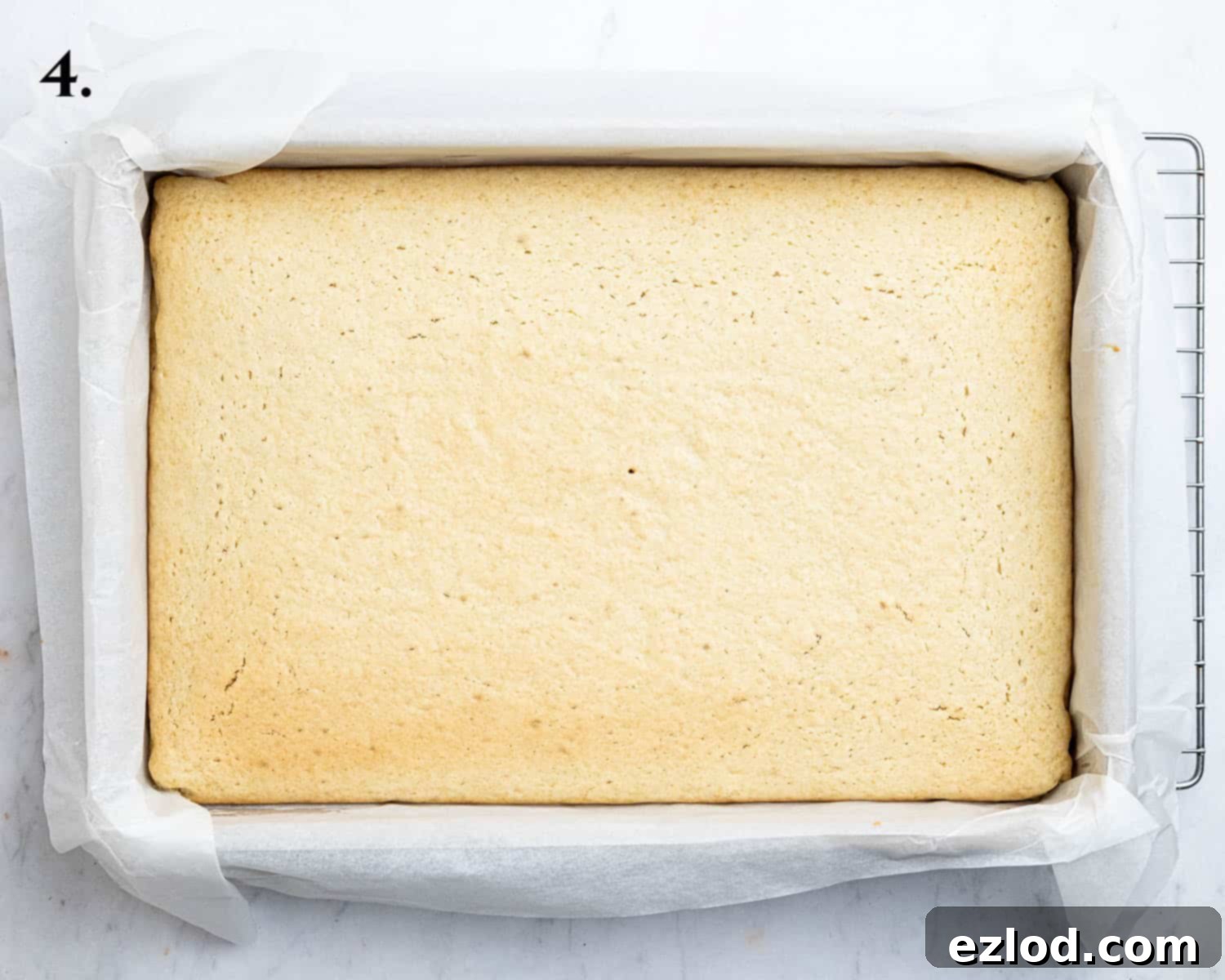
- Step 4: Place the tin in the preheated oven and bake for approximately 25 minutes, or until the cake is golden, firm to the touch, and a skewer inserted into the centre comes out clean.
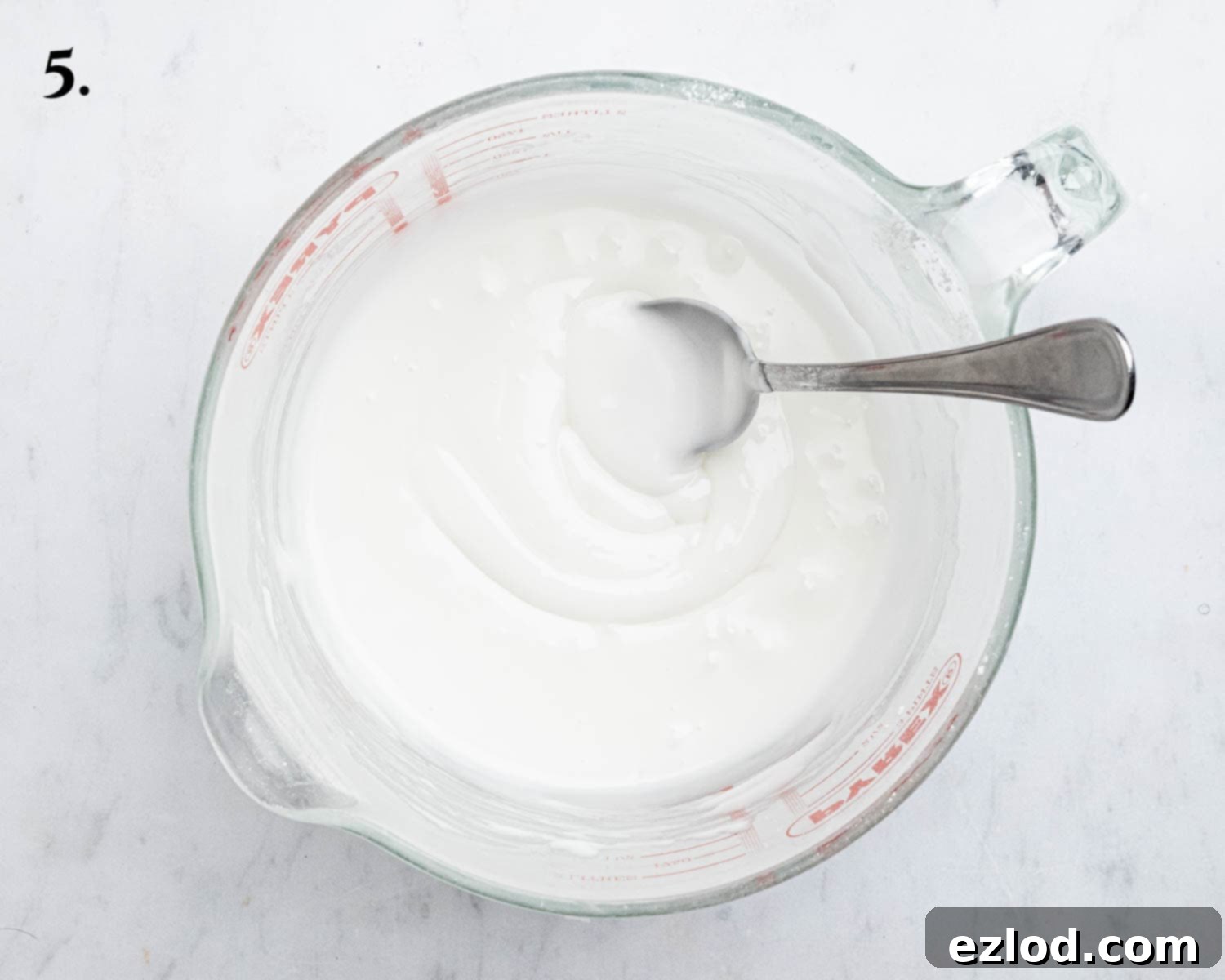
- Step 5: While the cake cools, prepare the glace icing. Sift the icing sugar into a clean bowl. Gradually add water, a tablespoon at a time, mixing continuously until you achieve a thick yet pourable consistency, similar to runny honey.
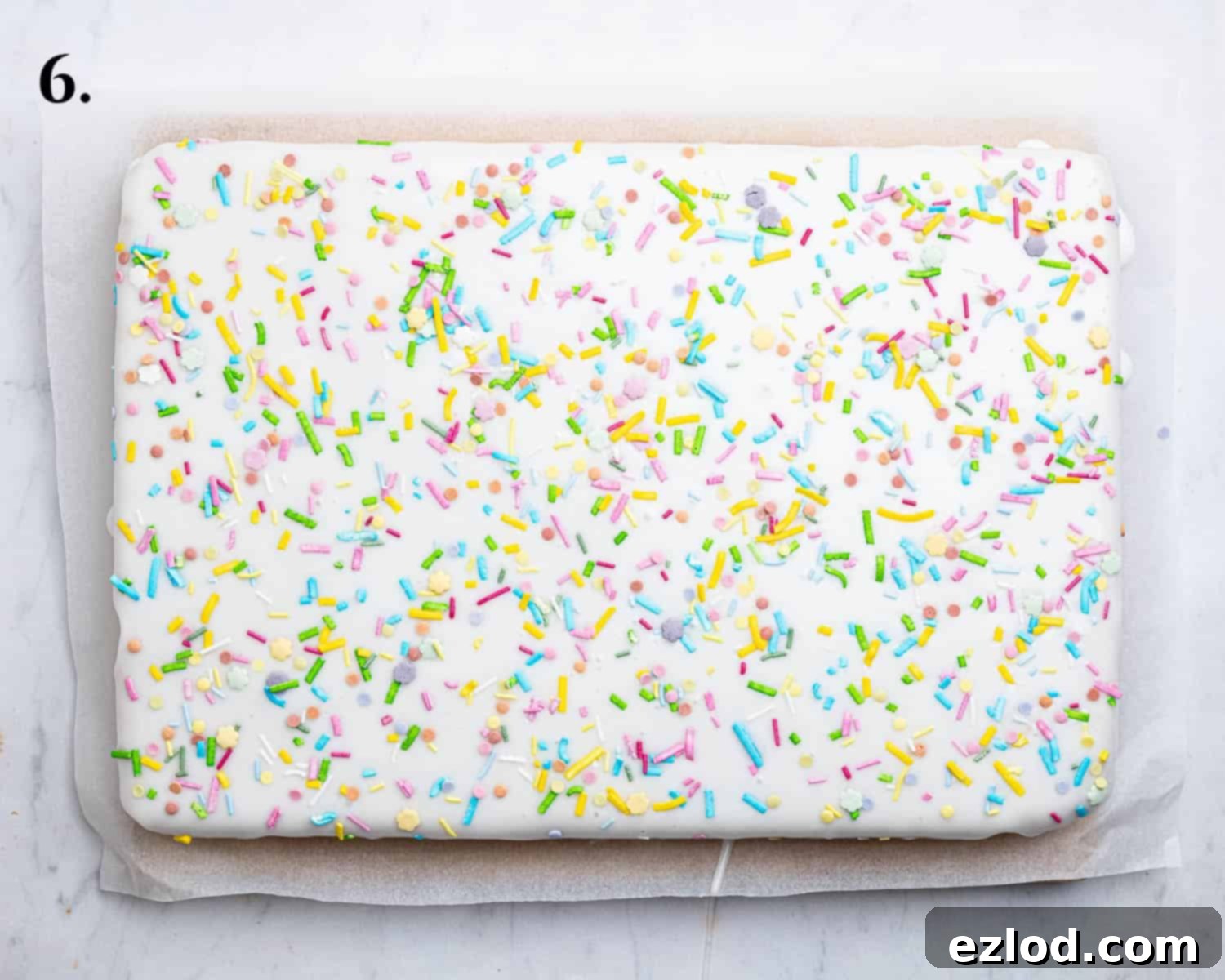
- Step 6: Once the cake is completely cool, drizzle the prepared icing evenly over the top. Immediately scatter with your chosen colourful sprinkles before the icing begins to set. Allow the icing to firm up, then slice into nostalgic squares and serve!
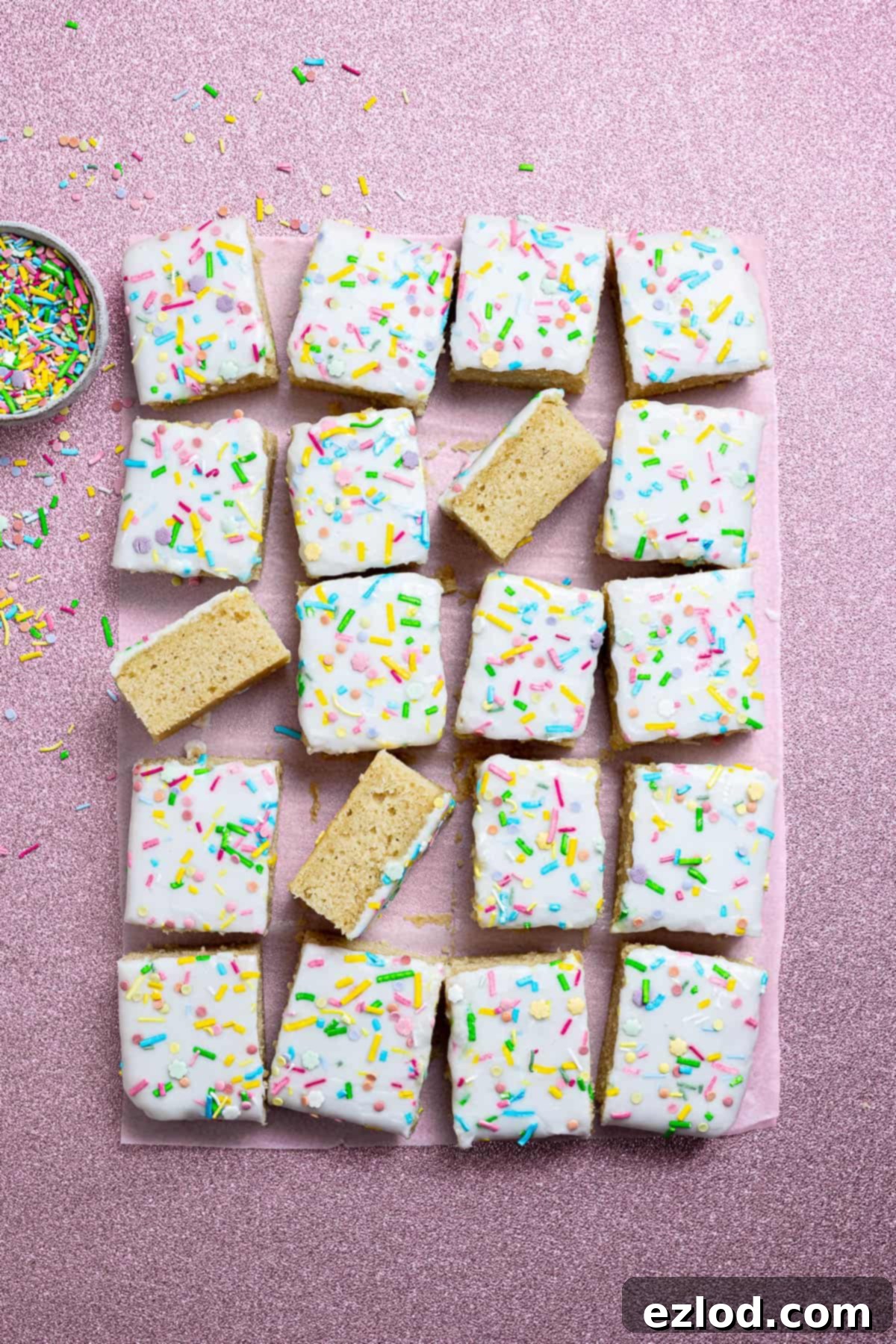
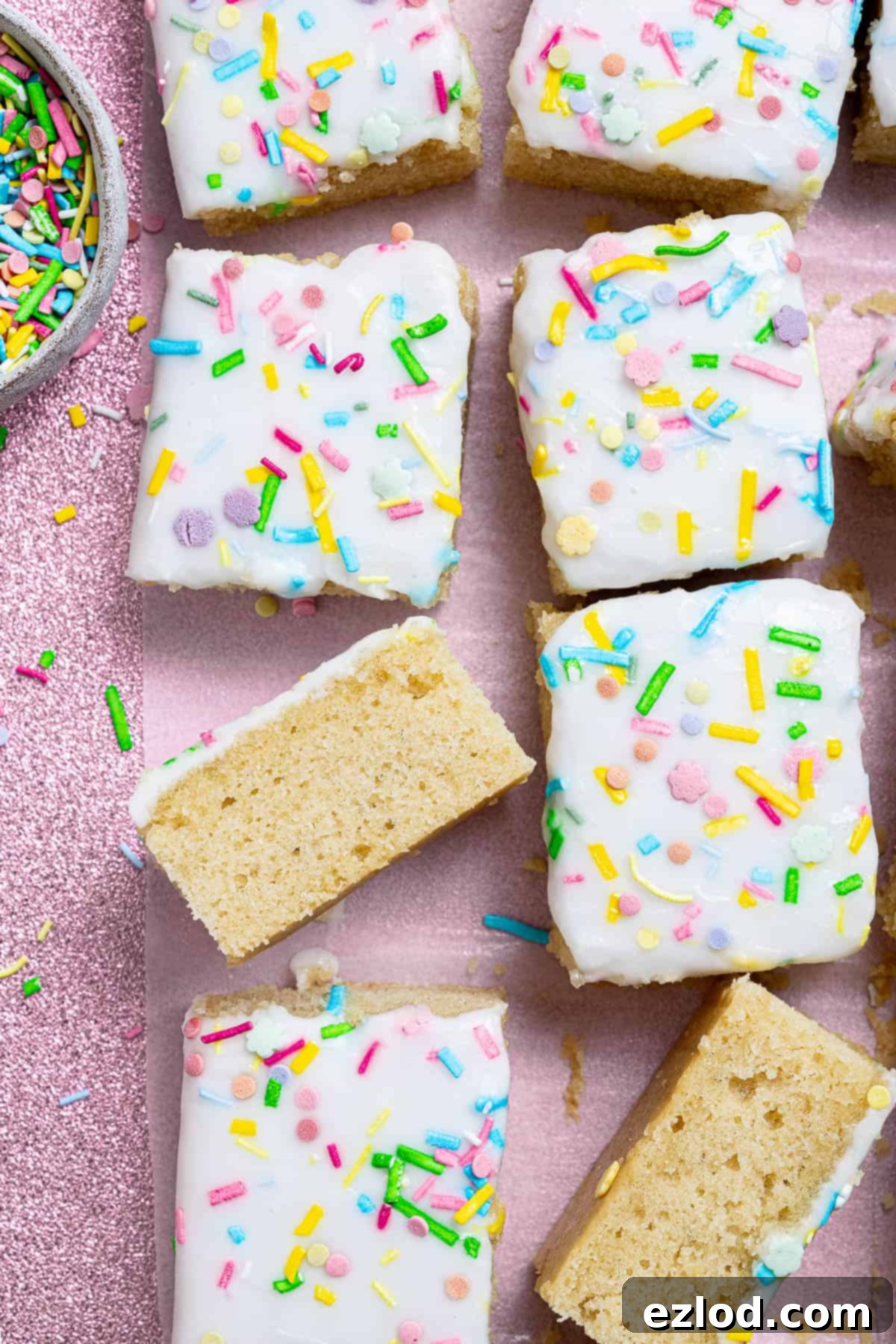
Expert Tips for Vegan School Cake Success
Achieving bakery-quality results at home is easier than you think with these essential tips:
Precision with a Digital Scale: When it comes to baking, accuracy is key, and this is especially true for vegan recipes. All of my recipes, including this vegan school cake, are meticulously developed using metric measurements in grams. I cannot stress enough the importance of using a digital kitchen scale rather than relying on cup conversions. Cups are a notoriously inaccurate measuring system; slight variations in how ingredients are packed can drastically alter the outcome. A digital scale ensures far more consistent and reliable results, and as an added bonus, it often leads to less mess and quicker clean-up!
Proper Measuring Spoons: Just like with dry ingredients, the accuracy of your tablespoon and teaspoon measurements matters. Always use proper measuring spoons designed for baking, not everyday kitchen spoons. A standard Tablespoon is exactly 15ml, and a teaspoon is 5ml. Ensure they are level (not heaped) for the correct quantity.
Avoid Over-mixing the Batter: When combining the wet and dry ingredients, be careful not to over-beat the batter. Flour contains gluten, and excessive mixing develops this gluten, which can result in a tough, chewy cake rather than a light and tender one. Instead of an electric mixer, gently stir the ingredients by hand with a balloon whisk until just combined and no dry lumps of flour are visible. A few small lumps are better than an overmixed batter.
Testing for Doneness: The cake is perfectly baked when it feels firm and springy to the touch in the centre. The most reliable test is inserting a skewer or toothpick into the middle of the cake; it should come out clean, or with just a few moist crumbs clinging to it, but never with wet batter.
Cool Completely Before Icing: This is a non-negotiable step! It’s absolutely crucial to allow the cake to cool down completely to room temperature before you even think about applying the icing. If you ice a warm cake, the heat will simply melt the glace icing, causing it to run off the sides and soak into the sponge, leaving you with a messy, uneven result instead of a beautiful, crisp topping.
Achieving Perfect Icing Consistency: The ideal glace icing should be thick enough to cling to the cake but still pourable, resembling the consistency of runny honey. Add water very gradually, a drop or two at a time. If you drizzle some icing back into the bowl, the pattern it creates should slowly disappear after about 8-10 seconds. If it’s too thick, add a tiny bit more water. If it becomes too runny, sift in a little more icing sugar to thicken it back up.
Timely Sprinkle Application: Once you’ve applied the icing, don’t delay in adding the sprinkles! Glace icing sets relatively quickly, and if you wait too long, the surface will become dry, and your colourful sprinkles won’t adhere properly. Scatter them generously while the icing is still wet and tacky to ensure they stick beautifully.
Creative Variations for Your Vegan School Cake
While the classic vegan school cake is perfect as is, it’s also a fantastic canvas for creative adaptations. Here are some delicious ideas to switch things up:
- Zesty Lemon Dream: Infuse your cake with bright citrus notes! Add the finely grated zest of 2-3 organic lemons to the cake batter. For the icing, swap out the water for freshly squeezed lemon juice to create a tangy, fragrant lemon glace.
- Subtle Almond: Introduce a sophisticated almond flavour. Stir in a teaspoon of almond extract into the cake batter. For the icing, add about ½ teaspoon of almond extract (or to taste) alongside the vanilla, creating a delicate and aromatic finish.
- Play with Colour for Any Occasion: Unleash your inner artist! Add a few drops of pink food colouring to the icing for a pretty pastel cake. For a fun Halloween treat, use orange food colouring and top with black sprinkles. For festive Christmas vibes, dye the icing green and decorate with cheerful red and white sprinkles.
- Classic Vegan Vanilla Sheet Cake: Transform this recipe into a versatile vegan vanilla sheet cake. Instead of the simple water icing, top it with a luxurious vanilla buttercream frosting or a rich, tangy vegan cream cheese frosting for an extra indulgent experience.
- Delightful Funfetti: If your chosen sprinkles are certified bake-stable (meaning their colours won’t bleed during baking), fold a few generous tablespoons directly into the cake batter just before pouring it into the tin. This creates a joyous funfetti effect throughout the sponge, adding an extra layer of visual appeal and celebration.
Frequently Asked Questions (FAQ’s)
This delicious cake will remain fresh and moist when stored in an airtight container at room temperature for approximately 3-4 days. Ensure it’s sealed well to prevent it from drying out.
Yes, you can freeze vegan school cake. For best results, I recommend freezing the un-iced cake if possible. Freezing the glace icing might make it slightly wet upon thawing and could cause the colours from the sprinkles to bleed into the white icing.
Wrap the baked and cooled cake tightly in several layers of cling film or aluminium foil to prevent freezer burn, then place it in a freezer-safe bag or container. It can be frozen for up to 3 months. When ready to serve, simply allow it to defrost at room temperature, then apply the icing and sprinkles.
This vegan vanilla sheet cake naturally bakes up with a fairly even top. However, for an absolutely pristine, perfectly flat surface ideal for icing, a simple trick is to flip the cooled cake upside-down before applying the icing. The flat bottom of the cake then becomes your perfectly smooth canvas for decoration.
Absolutely! If you’re baking for a smaller crowd or simply want a modest treat, a half batch of this recipe will work beautifully. Simply halve all the ingredient quantities and bake it in a 20 cm (8 inch) square cake tin.
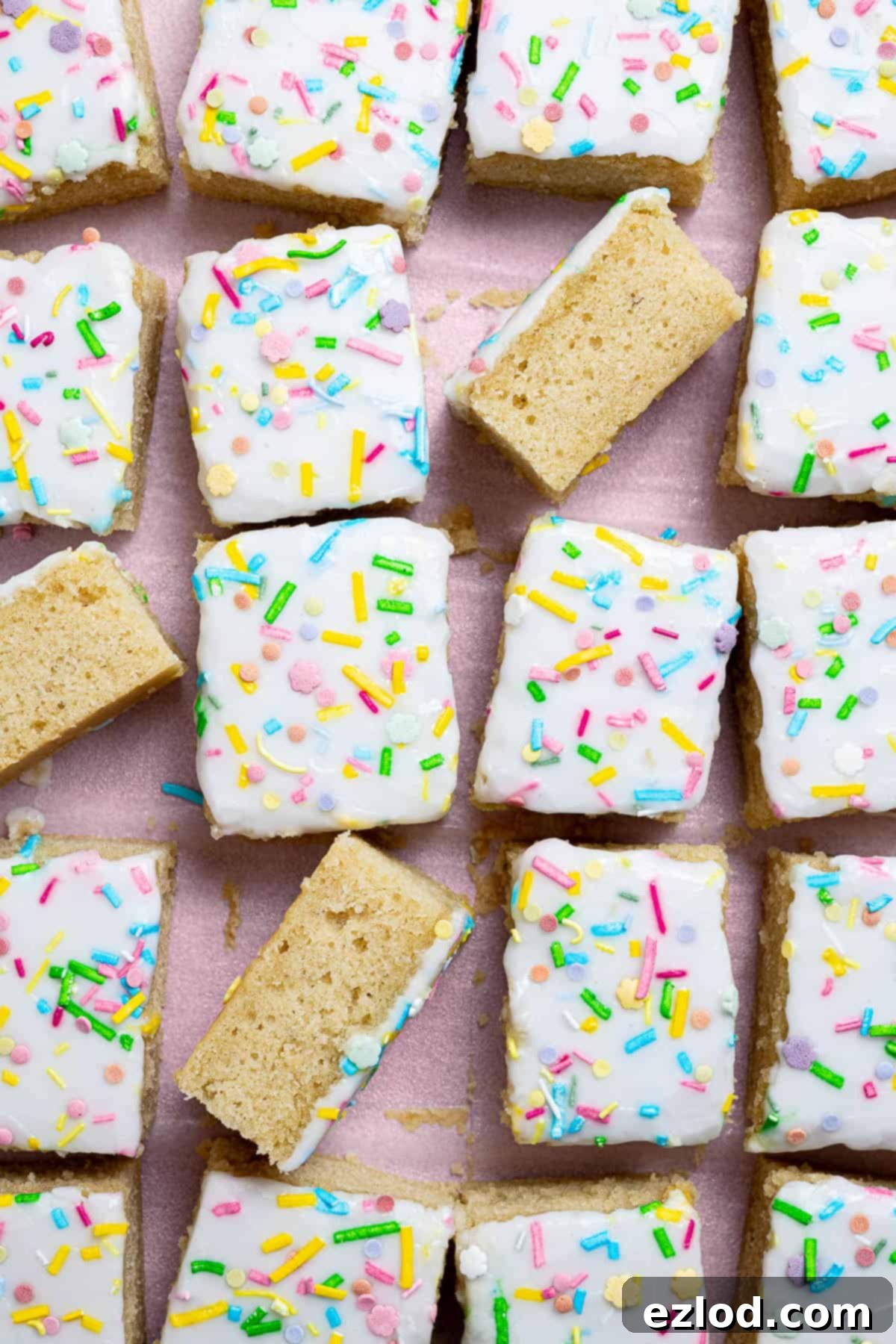
More Retro British Recipes Made Vegan:
- Vegan Jam and Coconut Sponge
- Vegan Golden Syrup Cake
- Vegan Angel Cake
- Vegan Jaffa Cakes
- Vegan Battenberg Cake
Stay in touch with me through social media @ Instagram, Pinterest and Facebook, and subscribe via email to get all our latest recipes!
All images and content on Domestic Gothess are copyright protected. If you want to share this recipe then please do so by using the share buttons provided. Do not screenshot or post the recipe or content in full, instead include a link to this post for the recipe.
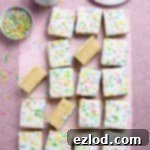
Vegan School Cake
Ingredients
Cake:
- 240 g (1 cup) unsweetened non-dairy milk (I use soy)
- 120 g (½ cup) plain non-dairy yogurt (I use soy) (or use more milk for a slightly denser cake)
- 83 g (6 Tablespoons) neutral oil (I use olive, avoiding strong flavours)
- 120 g (½ cup) vegan block butter melted (for best flavour and texture)
- 250 g (1 + ¼ cups) caster or granulated sugar
- 2 teaspoons vinegar (white wine or apple cider)
- 1 Tablespoon vanilla extract (or vanilla bean paste)
- 2 teaspoons baking powder
- ½ teaspoon bicarbonate of soda (baking soda)
- ½ teaspoon salt
- 400 g (3 + ⅓ cups) plain (all-purpose) flour
Icing:
- 450 g (4 cups) icing (powdered) sugar
- 1 teaspoon vanilla extract
- 4-5 Tablespoons water (adjust as needed for consistency)
- 2-3 Tablespoons sprinkles (ensure vegan-friendly)
Instructions
-
Preheat your oven to 180°C/160° fan/350°F/gas mark 4. Lightly grease a 23 x 33 cm / 9 x 13 inch rectangular cake tin and line it with baking parchment, leaving an overhang on two sides for easy removal.
-
In a large mixing bowl, combine the unsweetened non-dairy milk, plain non-dairy yogurt, neutral oil, melted vegan block butter, caster or granulated sugar, vinegar, and vanilla extract. Whisk these wet ingredients together thoroughly until the mixture is smooth and well combined.240 g (1 cup) unsweetened non-dairy milk (I use soy), 120 g (½ cup) plain non-dairy yogurt (I use soy), 83 g (6 Tablespoons) neutral oil (I use olive), 120 g (½ cup) vegan block butter, 250 g (1 + ¼ cups) caster or granulated sugar, 2 teaspoons vinegar, 1 Tablespoon vanilla extract
-
Into the wet mixture, gently whisk in the baking powder, bicarbonate of soda, and salt. Follow this by whisking in the plain (all-purpose) flour. Mix carefully by hand with a balloon whisk until all ingredients are just combined and no dry lumps of flour remain. Be cautious not to over-beat the batter, as this can lead to a tough cake.2 teaspoons baking powder, ½ teaspoon bicarbonate of soda (baking soda), ½ teaspoon salt, 400 g (3 + ⅓ cups) plain (all-purpose) flour
-
Pour the smoothly mixed batter into your prepared cake tin and spread it out evenly using a spatula to ensure a level surface. Bake in the preheated oven for approximately 25 minutes, or until the cake is golden, feels firm and springy to the touch, and a skewer inserted into its centre comes out clean.
-
Allow the baked cake to cool in its tin for about 20 minutes. After this initial cooling, carefully invert it onto a wire rack, remove the baking parchment, and let it cool completely to room temperature before proceeding with the icing.
-
To prepare the glace icing, sift the icing (powdered) sugar into a clean bowl. Add the vanilla extract and gradually mix in water, adding a couple of drops at a time, until you achieve a consistency that is very thick but still pourable (like runny honey). If it becomes too thick, add a tiny bit more water; if too runny, sift in more icing sugar to adjust.450 g (4 cups) icing (powdered) sugar, 1 teaspoon vanilla extract, 4-5 Tablespoons water
-
Once the cake is completely cool, drizzle the prepared icing evenly over the top. For an extra smooth, perfectly flat surface, you can flip the cake upside-down before icing it. Use a palette knife or the back of a spoon to spread the icing level.
-
Immediately scatter your chosen sprinkles generously over the wet icing. Allow the icing to set for approximately 30 minutes (or until firm to the touch) before carefully slicing the cake into nostalgic squares and serving.2-3 Tablespoons sprinkles
Notes
- For additional helpful baking tips, ingredient details, and visual step-by-step photos, please refer to the main blog post content above.
- All of my recipes are meticulously developed and tested using metric measurements in grams. For the most accurate and consistent baking results, I highly recommend using a digital kitchen scale for dry ingredients rather than volume-based cup conversions. This method ensures precision and often leads to less mess!
- It is absolutely crucial that the cake is completely cool before you apply the icing. Attempting to ice a warm cake will cause the glace icing to melt, run off, and be absorbed into the sponge, resulting in a less than ideal finish.
If you’ve tried this delightful vegan school cake recipe, I’d love to hear your thoughts! Please rate it, leave a comment below, or share your creations by tagging @domestic_gothess on Instagram and using the hashtag #domesticgothess. Your feedback is greatly appreciated!
